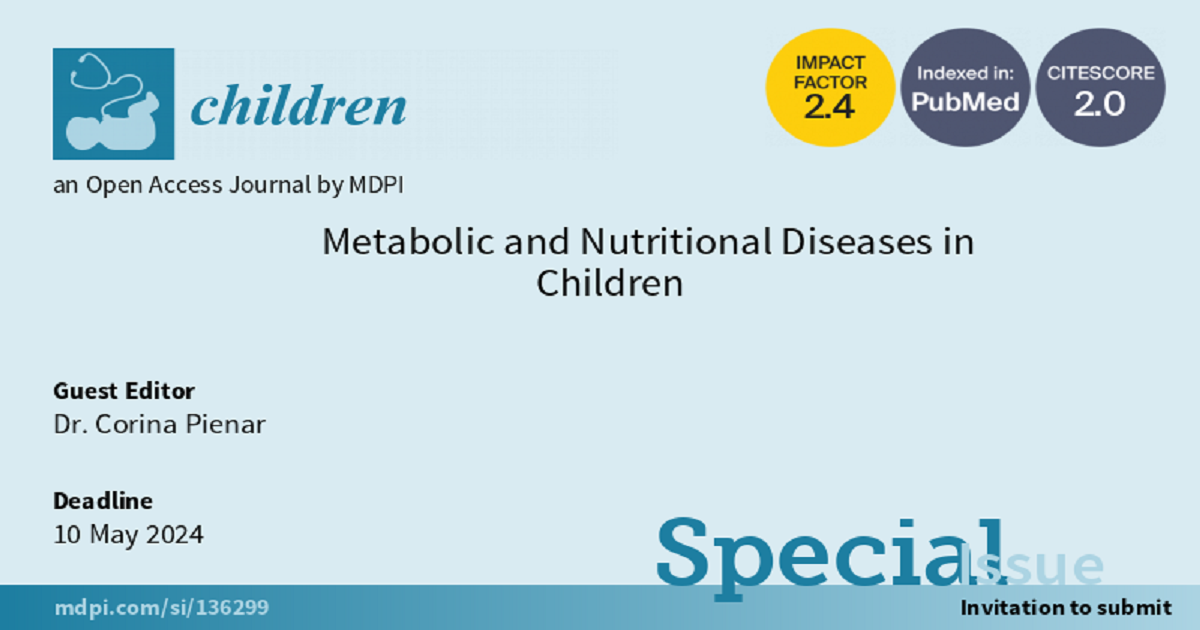Metabolic and Nutritional Diseases in Children
A special issue of Children (ISSN 2227-9067). This special issue belongs to the section "Pediatric Endocrinology".
Deadline for manuscript submissions: 10 May 2024 | Viewed by 16007

Special Issue Editor
Special Issue Information
Dear Colleagues,
It is my great pleasure to invite you to contribute to this Special Issue of Children on “Metabolic and Nutritional Diseases in Children”.
In pediatrics, metabolic and nutritional diseases encompass a broad group of pathological entities. From the most common food protein allergies and disaccharide intolerances to the rarest metabolic diseases, this group of pediatric illnesses negatively impacts the health, growth, and quality of life of affected children.
In recent decades, advances in molecular testing, endoscopic procedures, and imaging have led to increased awareness and diagnosis of metabolic and nutritional diseases. Still, their management remains a challenge, bringing together a team of experts, such as pediatricians, pediatric gastroenterologists, endocrinologists, dieticians, geneticists, and imagists.
This Special Issue of Children, “Metabolic and Nutritional Diseases in Children”, aims to include research that will advance current knowledge in the field of metabolic and nutritional diseases. The papers need to explore diagnostic challenges, present new techniques, or validate existing tools that assess metabolic and nutritional diseases and provide new insights into how therapeutic interventions can improve health, growth, and quality of life in children with metabolic and nutritional diseases.
Dr. Corina Pienar
Guest Editor
Manuscript Submission Information
Manuscripts should be submitted online at www.mdpi.com by registering and logging in to this website. Once you are registered, click here to go to the submission form. Manuscripts can be submitted until the deadline. All submissions that pass pre-check are peer-reviewed. Accepted papers will be published continuously in the journal (as soon as accepted) and will be listed together on the special issue website. Research articles, review articles as well as short communications are invited. For planned papers, a title and short abstract (about 100 words) can be sent to the Editorial Office for announcement on this website.
Submitted manuscripts should not have been published previously, nor be under consideration for publication elsewhere (except conference proceedings papers). All manuscripts are thoroughly refereed through a single-blind peer-review process. A guide for authors and other relevant information for submission of manuscripts is available on the Instructions for Authors page. Children is an international peer-reviewed open access monthly journal published by MDPI.
Please visit the Instructions for Authors page before submitting a manuscript. The Article Processing Charge (APC) for publication in this open access journal is 2400 CHF (Swiss Francs). Submitted papers should be well formatted and use good English. Authors may use MDPI's English editing service prior to publication or during author revisions.
Keywords
- pediatric nutrition
- metabolic diseases
- cystic fibrosis
- obesity
- celiac disease
- disaccharide intolerances
- food protein allergies
- inflammatory bowel disease
- diabetes mellitus






